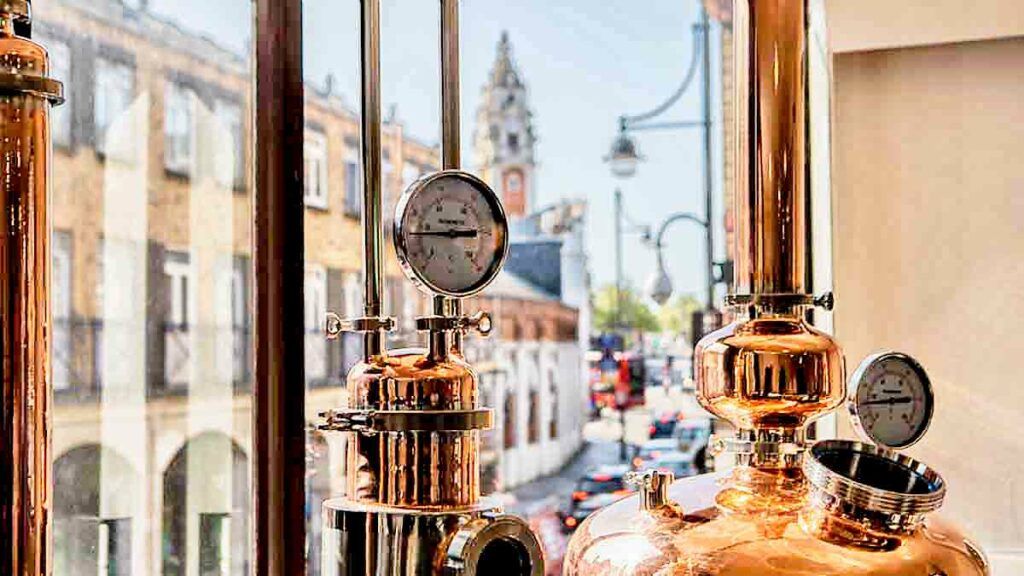The Brixton Distillery Company captures the excitement, buzz and innovation that has made this part of south London such an important part of the still exploding craft drinks and food scene.
Finding Brixton Distillery Co. was a bit like finding a speakeasy bar. I stood exactly at the point on the map where it is located, but the entrance was nowhere to be seen. A voice called out to me from an unassuming doorway – it was Patrick Venning, ex-Chivas Brothers’ marketing director. I was in.
Venning’s energy is immediately infectious. After 20 years in marketing for some of the biggest names in the business, he and Laurent Lacassagne, former chairman and chief executive of Chivas Brothers, decided to turn their hands to a project of their own.
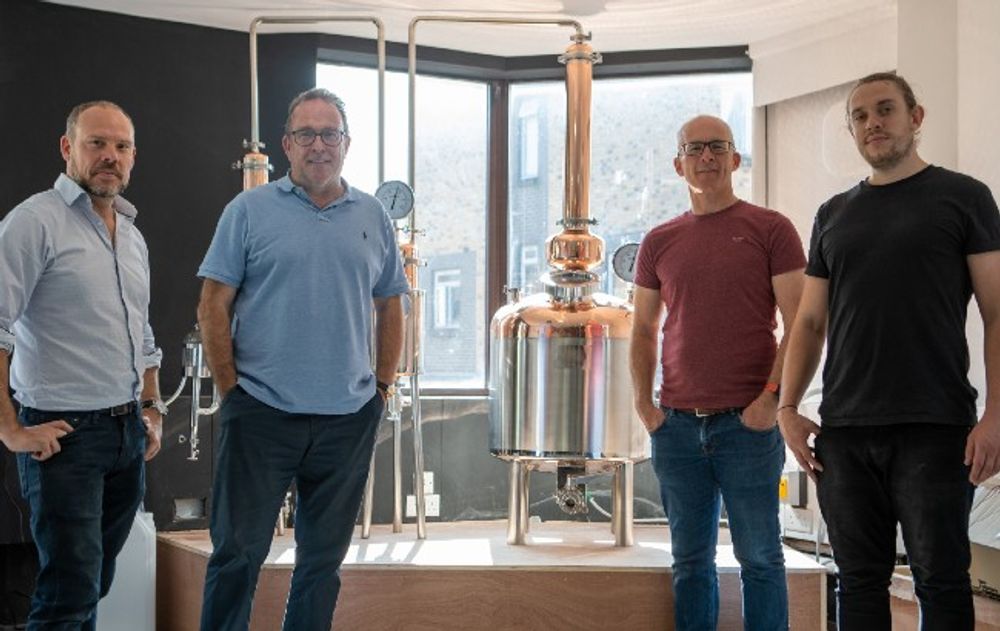
The Brixton Distillery team: (Left to right) Matt Servini, Laurent Lacassagne, Patrick Venning and Mikey Hirsch
They created an “urban London rum” called Market Row Botanical Rum. Venning’s been forced to get his hands dirty, and he seems to be loving it. He described dealing with the mundanities of setting up shop with exhausted glee, like figuring out how to get 300kg barrels up into the first-floor micro distillery when the building’s lift was broken.
The distillery sits in Impact Brixton, a community-led co-working space above Brixton’s Market Row arcade, with enviable views out over the market. Brand ambassador Mickey Hirsch tells me: “It’s really nice for us being part of this community space because the concept of Market Row is to be part of the Brixton community.”
Its 100-litre still, Eddy (named after Brixton reggae legend Eddy Grant), has pride of place in the window while the team work on a large desk beside it. It’s cute – though I’m not sure Venning was too enamoured when I said I thought so.
Why Brixton?
The brand has really tried to lay down its roots in Brixton, although its founders have no obvious personal connection there. “Culture is part of rum’s history, and there are two places that represent the Caribbean in London – Brixton and Notting Hill,” says Venning. “We didn’t want to be a brand that just existed on PowerPoint. We wanted to put our roots down in Brixton. It takes time to build trust to show that you’re not just an interloper using the Brixton brand. I think people have been so, so supportive.”
Market Row has collaborated with local businesses as much as possible to help with its launch. “We are always looking for local people, like creatives, and there are already a lot here,” says Hirsch.
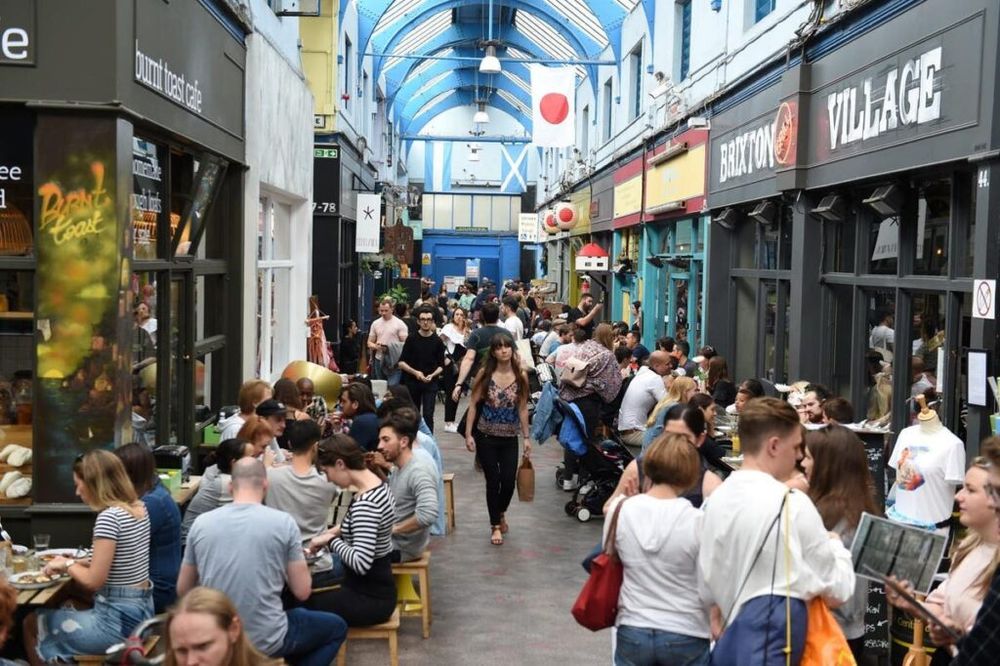
Brixton Distillery Company is in the heart of the new thriving Brixton full of craft food and drinks producers, bars, restaurants and shops
Brixton Street Wear makes its t-shirts and a lot of the botanicals are purchased from the market stalls. The Market Row logo is a stylised map of Brixton, showing the crossing of iconic Brixton streets Coldharbour Lane and the A23. “It’s a fun place”, says Venning. “We eat far too much because Brixton’s amazing for food.”
Going solo
Venning started his career with Procter and Gamble and moved up in the business through a series of strong marketing and PR roles, before working with Lacassagne at Chivas. The pair bumped into each other after leaving the company and Lacassagne shared his idea of building a premium rum brand in Brixton. “Premium rum category is in growth in a number of markets,” says Venning, who was keen to get involved.
Lacassagne led the product development. Venning led on the brand. They began development in June 2019 and officially launched 16 months later in October 2020.
Venning says the network built from his years at Pernod Ricard has been invaluable in his new venture. “There’s always someone to pick up the phone to when you need help with something,” he says.
He has found setting up solo after working commercially to be incredibly rewarding. He gets a ping on his phone when they sell a case of rum or are out of stock. “It’s so much more exciting because you don’t know what each day is going to bring for you. When things go well it’s your work and your team’s. But there are some really stressful points to it as well. When something goes wrong, for the first few hours you want to pack up. But you need people around you to help you find the solutions.”
The rum
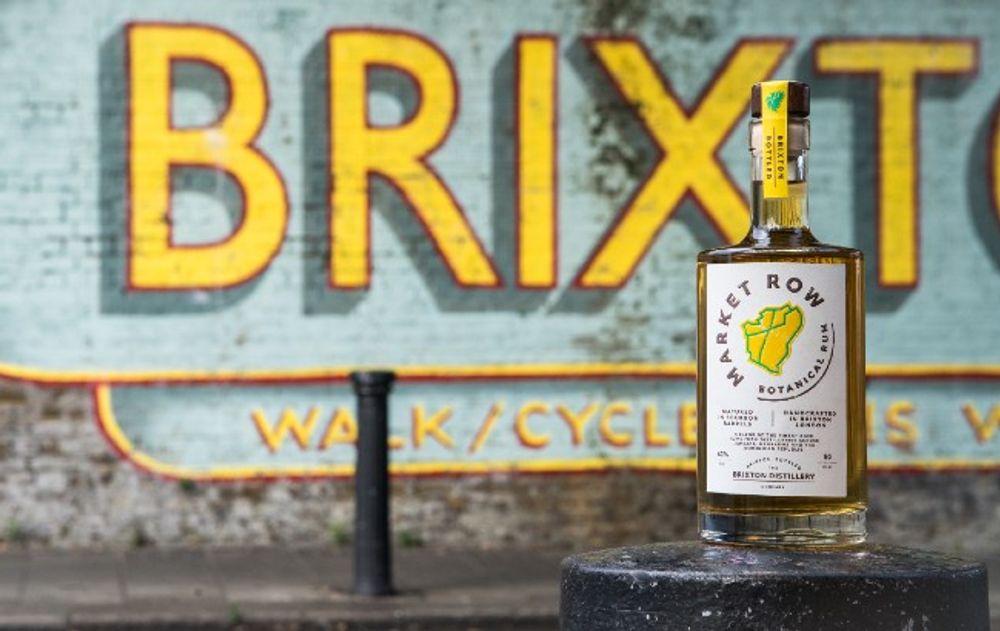
What it’s all about: Market Row rum which has just won silver in the International Spirits Challenge
Market Row’s rum is made from a blend of aged Caribbean rums (Bajan and Dominican) and un-aged sugar cane rums from the Dominican Republic. They are brought to Brixton where master distiller, Matt Servini, adds botanicals including black tea, hibiscus, and red rose. It is bottled without any additional sugar, flavourings or colouring. Everything is made and packaged on site.
It is technically a spiced rum, but Hirsch explains that there are some misconceptions around spiced rum, which can be overly sweet with cinnamon, vanilla, and banana flavours. “This is not the way we want to go, which is why we went with ‘botanical rum’,” he says. The perception of rums is that golden rum is more premium, but they hope to add a white rum to the brand in the future. Hirsch thinks a white rum will work well with the infusion method as the botanicals stand out a little more, like in gin.
In terms of serves, Hirsch says “part of our aim is the mixer strategy – I have not found a mixer that it does not work with yet”. In cocktails the botanicals become more prominent, and the team has been working on signature serves to match with each botanical. The allspice goes well in a Manhattan and the black tea in an old fashioned. (More serves can be found on the website).
The rum category
“The opportunity for us in rum was trying to address why there is still plenty of opportunity in rum – a lot of people don’t understand it,” says Venning. He has found that it’s often considered too sweet, perhaps too masculine, and not premium enough.
Have they encountered many rum purists who are aghast at adding botanicals to already award-winning rums? “I am sure there are those purists, but you are just delaying the inevitable,” Venning feels. “Look at the innovation in gin, it’s been huge. Gin has been going for about eight centuries, but only now are we getting premium gin. Rum used to be dark and golden, now it’s spiced and botanical. Embrace the new rums coming into the market because it will become a diverse category.”
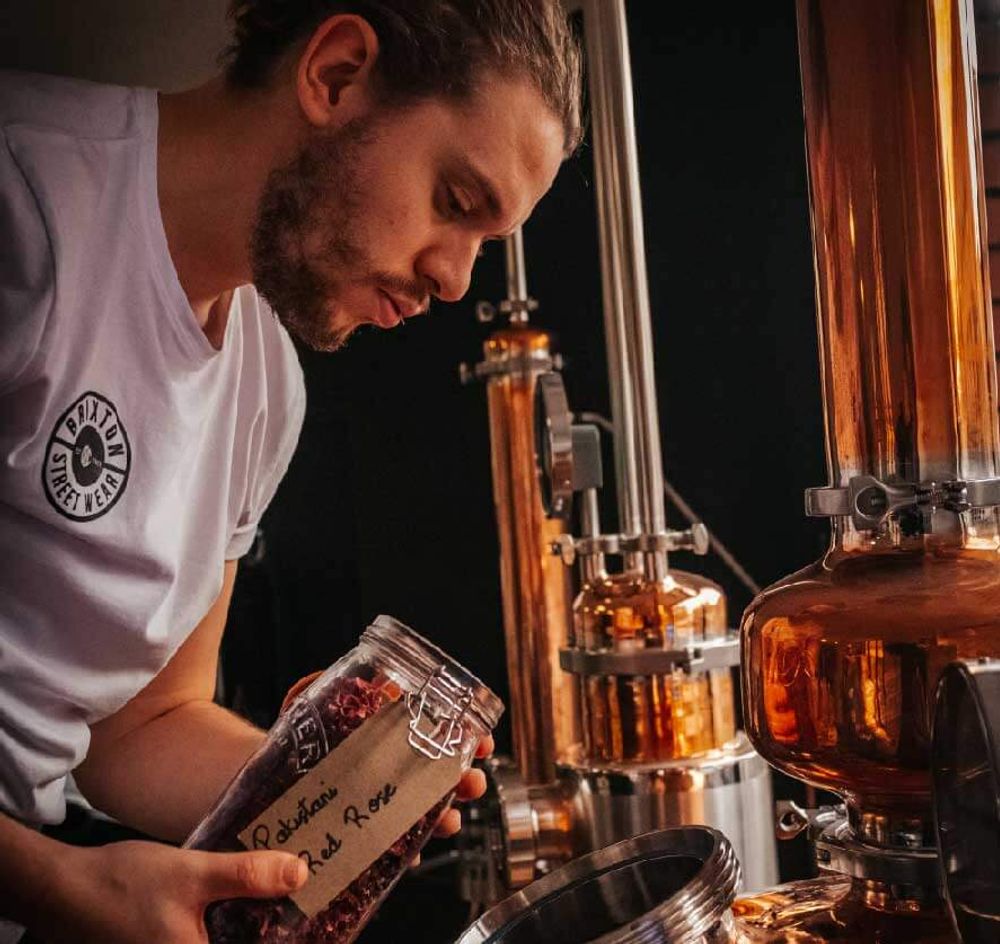
Mikey Hirsch is keen to push the boundaries with rum at Brixton Distillery Company
Hirsch agrees: “Rum has as many purists as whisky drinkers. We have been very aware that Market Row is a celebration of rum and the Caribbean. We are not trying to redefine or disrespect rum. I’ve found a lot of people are very excited to see a new brand and have a new product. There’s no such thing as a ‘bad’ rum.”
Education is going to be an important part of the brand’s strategy moving forward. Changing consumer habits and perceptions is difficult, and the team plans to educate people on what makes a good-quality rum through its comms and social media. “Brand image will be key,” Hirsch says. They also hope to be able to open up the distillery space for consumers to do blending workshops once lockdown is over, as well as training for the on-trade.
Hirsch explains: “I hope to get people here to taste all the separate rums together, so they can see what they bring to the blend and why each botanical is added.”
A rum craze?
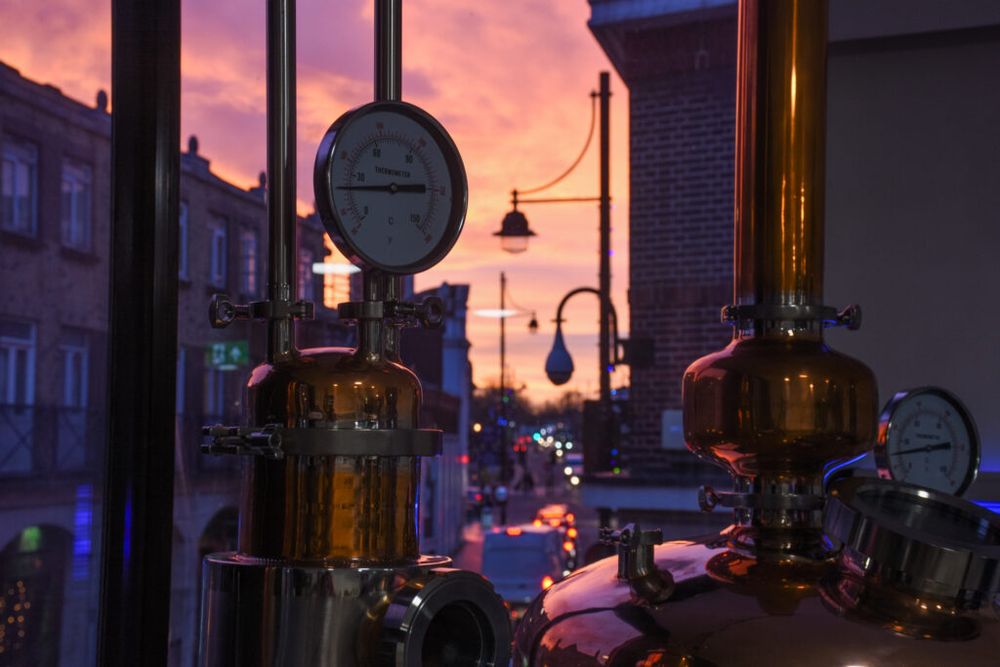
The craft stills look out on the Brixton landscape
So will rum ever rival gin? Venning thinks not. “Rum will never ever be the size that gin is”, he says, “When you look at how to make a rum, the barriers to entry are immediately higher. You need funds from the start.”
While he doesn’t see the rum category growing to the size of the gin category, he feels it will go down the premiumisation route. Quality is the key. “The level of expertise to make a great rum I think is a lot higher than to make a great gin. We’ve been playing around with the botanicals to bring out the best in Market Row rum. If you have invested a huge amount of your investment costs to bring in a top-quality rum, you don’t want to ruin it.”
As Victor Smart reported on The Buyer in November, part of Market Row’s strategy is “testing how far you can ‘premiumise’ rum, which has so far been relatively untouched by the boom in super- and ultra-premium brands which gin has so conspicuously enjoyed.
What’s next?
“The next year will be a really important year for Market Row”, says Venning. He plans to really focus on growing, and the three-year strategy is to really drive an on-trade presence focusing on premium bars and restaurants. This year the focus will be on South London: Brixton and its adjoining suburbs. “Ideally we’d like to be behind every bar in Brixton,” says Hirsch.
Next year they plan to broaden the focus in London and other key cities across the UK, before looking into global markets in a few years’ time. “There is a growing rum market in France”, says Venning.
The team is clearly itching to bring the rum to the trade properly as soon as possible and show the world what Market Row is all about. Hirsch’s parting words to me were: “People love it so far. The only way is up!”
After the year we’ve just had, I’ll cheers to that.
- To find out more about Market Row rum and the Brixton Distillery Company click here.
